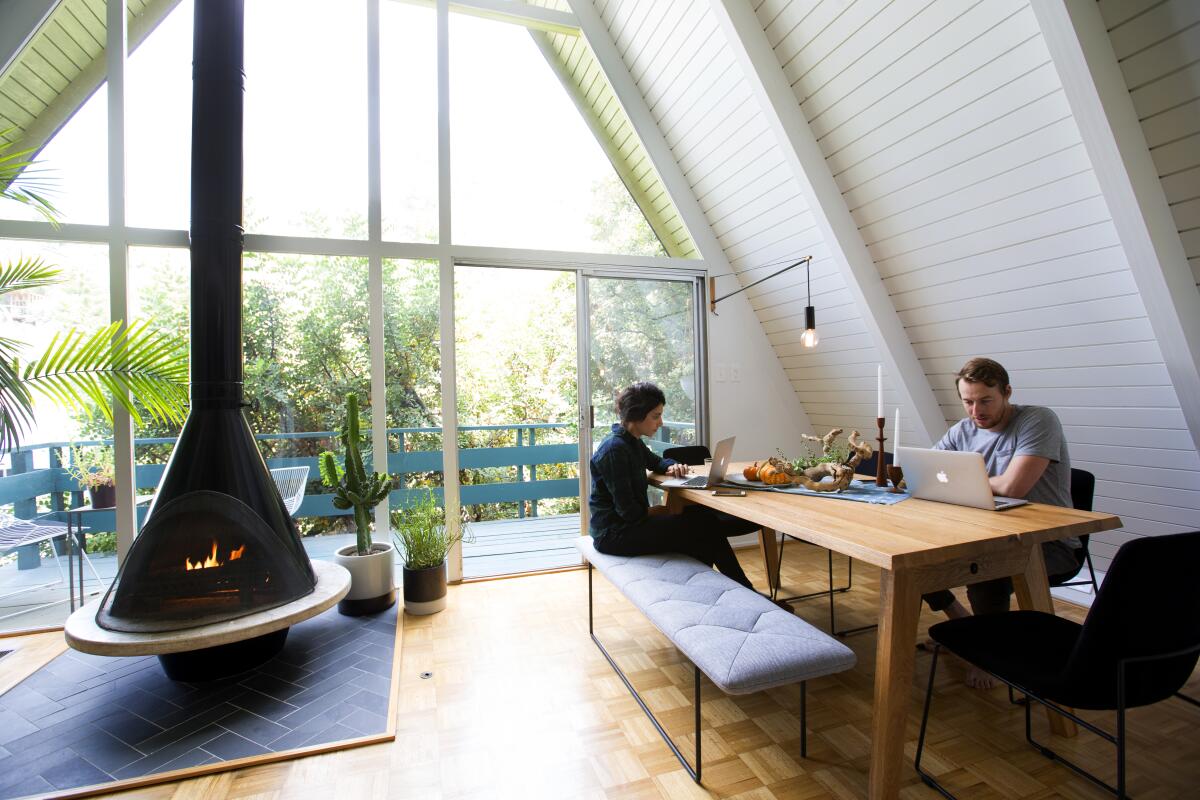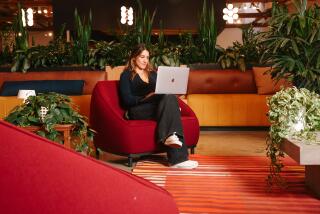WFH got you stiff and sore? An ergo expert offers 8 tips to stay healthy

Most of us are working from home now as the fast-spreading coronavirus has forced us to shelter in place.
That means that many of us are working remotely in less than ideal ergonomic situations as we type on laptops in bed, on bookshelves, on the couch and at the kitchen table.
Staying home may be the right thing to do for the greater good, but it can be the wrong thing for your body, especially if you’re working at an impromptu desk with spouses, roommates, children and pets underfoot.
As a result, many of us are feeling stiff and sore, no matter how many online yoga classes we do.
“There is a saying that ‘the best position is the next position,’” says Agoura Hills-based ergonomics consultant Karen Loesing, an expert in evaluating work stations.
The key, Loesing says, is to break up the work day with stretching, walking and a variety of postures. Here, Loesing offers 8 tips on how to stay healthy while working from home, plus some shopping inspiration in case you need to upgrade your WFH station.
Many employees working remotely in the midst of the coronavirus crisis are competing with roommates for limited space, internet connection and attention.
1. Use your home computer
Use your home computer so that you don’t work exclusively on your laptop. If you can work on a bigger monitor, consider purchasing one. “The monitor is the key to everything,” Loesing says. “You want to look straight ahead while you are working.”
If you can’t live without two monitors, use your laptop as a second monitor.
Adjust your monitor so that it is directly in front of you at arm’s distance (or a bit more) and your head is about 3 inches below the top of the monitor.
2. Riser
An inexpensive laptop riser will allow you to bring your monitor to your eye level. Books will also do the trick. Loesing recommends the Nulaxy laptop stand, $75, and the Soundance laptop stand, $34.
3. External keyboard and mouse
Invest in an external keyboard and mouse such as the Logitech K400 Plus wireless touch TV keyboard with a built-in touchpad, $26.99, or the Logitech MK345 wireless combo, $49.99.
Adjust your desk and keyboard tray height so that your keyboard and mouse are level or slightly below elbow height.
Keep your shoulders relaxed and your wrists straight while operating the keyboard and mouse.
With your arms at your sides and your elbows at 90 degrees, your fingers should reach the keyboard home row.
4. Seating
Not everyone can afford an Aeron chair, a popular work chair that can cost as much as $1,600. Still, Loesing says, “You get what you pay for.” Loesing likes the the Mirra 2 work chair, starting at $600 on the Herman Miller website; the Leap ($880) and the Gesture ($938) from Steelcase; as well as customizable chairs by Bodybilt and Ergocentric. Note: Work-related desks and chairs are tax-deductible.
Adjust the height of your chair so that your feet are on the floor, or on a footrest.
Adjust the back of your chair so that the lumbar support is positioned slightly below your belt line.
There should be a two- to three-finger width between the edge of your seat and the back of your knees.
Adjust your chair, whether with pillows or mechanical adjustments, so that your elbows are the same height as the desk.
It’s important to mix it up a bit, Loesing says. “If you want to sit on your couch for 15 minutes, that’s fine. One of the nice things about being at home is being able to sit and stand and mix it up,” says Loesing. “It’s OK to go sit and work on your easy chair, but not for more than a half hour.”
Learn how to use your chair if it’s adjustable.
Millions of people around the world might be working from home for a while. Try to enjoy it.
5. Posture
When sitting, try to recline by 10 to 15 degrees. “Most people think, incorrectly, that they should be sitting with their back at 90 degrees,” Loesing says. A slight recline will take the pressure off your hip flexors. “You know when you get up from a chair and you feel like you are 100 years old? That’s because your hips are tight from sitting at 90 degrees.”
6. Move
Take a walk. Do some stretches. If there is one particular part of your body that is bothering you, do some stretches for that problem area. Try to change your posture twice an hour and aim to perform some tasks while standing throughout the day.
Use software break reminders such as Fade Top or Stretchclock or smartphone apps such as UP or Stand Up.
Alan Hedge, Cornell professor emeritus and a noted expert on ergonomics, recommends getting up to stand and stretch every 20 minutes.

7. The desk
The average desk is 29 inches high, and most kitchen tables are even higher. “It’s too high for everyone,” Loesing says. Raise your chair so that your elbows are the same height as the table and place something under your feet if they are dangling. Step stools are often too high. You need a 4-inch support for your legs so that they are at 90 degrees.
8. Footrest
It’s worth investing in a footrest as sheltering in place continues. “A lot of people perch at the edge of their chair because the table is too high,” says Loesing. “If you have a footrest, it pushes you back in your chair so that your back is supported.” Loesing recommends the Fellowes office suites adjustable footrest, $44 at Staples, and the Kensington Solemate Plus (both height adjustable), $40 at Office Supply.
More to Read
Sign up for The Wild
We’ll help you find the best places to hike, bike and run, as well as the perfect silent spots for meditation and yoga.
You may occasionally receive promotional content from the Los Angeles Times.











